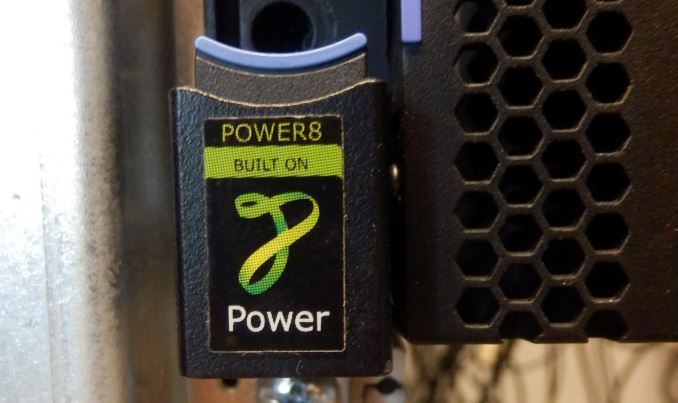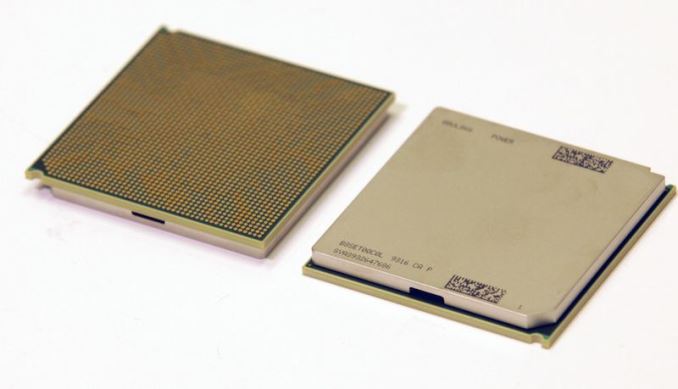The IBM POWER8 Review: Challenging the Intel Xeon
by Johan De Gelas on November 6, 2015 8:00 AM EST- Posted in
- IT Computing
- CPUs
- Enterprise
- Enterprise CPUs
- IBM
- POWER
- POWER8
Comparing Benchmarks: AT vs IBM
Before we close things out, let's spend a moment summarizing our results and comparing the performance we saw to the kind of performance advantages that IBM advertises POWER8 is capable of.
From a high level perspective, the S822L is more expensive and consumes a lot more power than a comparable Xeon system.
With limited optimization and with the current Ubuntu 15.04, the performance-per-watt ratio favors Intel even more as the POWER8 barely outperforms the very efficient 120W TDP Xeons. So there is no denying that the Intel systems offer a superior performance/watt ratio.
However, it would be unfair to base our judgement on our first attempt as we have to admit this our first real attempt to benchmark and test the POWER8 platform. It is very likely that we will manage to extract quite a bit more performance out of the system on our second attempt. IBM POWER8 also has a big advantage in memory bandwidth. But we did not manage to port OpenFOAM to the POWER platform, probably the most likely candidate for leveraging that advantage.
We are less convinced that the POWER8 platform has a huge "raw CPU compute advantage," contrary to what for example IBM's SPECJBB (85% faster ) and SAP (29% faster) results seem to suggest.
For example, IBM's own SPECjEnterprise®2010 benchmarking shows that:
- Two Xeon E5-2697 v3, 14 cores at 2.6-3.1 GHz score 19282
- Two POWER8, 12 cores at 3.5-3.8 GHz score 22543
SAP is "low IPC" (hard to run many instructions in parallel in one thread) software that benefits much from low latency caches. The massive L3-cache (12-cores, 96 MB) and huge thread count are probably giving the IBM POWER8 the edge. The RAM bandwidth also helps, but in a lesser degree. IBM clearly built POWER8 with this kind of software in mind. We had individual threadcount intensive benchmarks (LZMA decompression) and L3-cache sensitive benchmarks (ElasticSearch), but t o be fair to IBM, none of our benchmarks leveraged the three strongest points (threadcount, L3-cache size and memory bandwidth) all at once like SAP.
SPECJBB2013 has recently been discontinued as it was not reliable enough. We tend to trust the jEnterprise test a lot more. In any case, the best POWER8 has a 17% advantage there.
Considering that the POWER8 inside that S824 has 20% more cores and a 3% higher clockspeed, our 3.4 GHz 10-core CPU would probably be slightly behind the Xeon E5-2697 v3. We found out that the 10-core POWER8 is slightly faster than Xeon E5-2695 v3. The Xeon E5-2695 v3 is very similar to the E5-2697 v3, it is just running at a 10% lower clockspeed (All core turbo: 2.8GHz vs 3.1GHz). So all in all, our benchmarks seems to be close to the official benchmarks, albeit slightly lower.
Closing Thoughts: A Mix of Xeon "E5" and "E7"
So let's sum things up. The IBM S822L is definitely not a good choice for those looking to lower their energy bills or operate in a location with limited cooling. The pricing of the CDIMMs causes it to be more expensive than a comparable Xeon E5 based server. However, you get something in return: the CDIMMs should offer higher reliability and are more similar to the memory subsystem of the E7 than the E5. Also, PCIe adapters are hot-pluggable on the S822L and can be replaced without bringing down the system. With most Xeon E5 systems, only disks, fans and PSU are hot-pluggable.
In a number of ways then, the S822L is more a competitor to dual Xeon E7 systems than it is to dual Xeon E5 systems. In fact, a dual Xeon E7 server consumes in the 600-700W range, and in that scenario the power usage of S822L (700-800W) does not seem outrageous anymore.
The extra reliability is definitely a bonus when running real time data analytics or virtualization. A failing memory chip may cost a lot when you running fifty virtual machines on top of a server. Even in some HPC or batch data analytics applications where you have to wait for hours for a certain result that is being computed in an enormous amount of memory, the cost savings of being able to survive a failing memory chip might be considerable.
One more thing: for those who need full control, the fact that every layer in the software stack is open makes the S822L very attractive. For now, the available "OpenCompute" Xeon servers that are also "open" seem to mostly density optimized servers and the openess seems limited on several levels. Rackspace felt that the current OpenCompute servers are not "open enough", and went for OpenPOWER servers instead. In all those markets, the S822L is very interesting alternative to the dual Xeon E5 servers.
Ultimately however, the performance-per-dollar Xeon E5 competitors will most likely be OpenPOWER third party servers. Those servers do not use CDIMMS, but regular RDIMMs. Other components such as disks, networkcards and PSUs will probably be cheaper but potentially also slightly less reliable.
All in all, the arrival of OpenPOWER servers is much more exciting than most of us anticipated. Although the IBM POWER8 servers can not beat the performance/watt ratio of the Xeon, we now have a server processor that is not only cheaper than Intel's best Xeons, but that can also keep up with them. Combine that with the fact that IBM has lined up POWER8+ for next year and a whole range of server vendors is building their own POWER8 based servers, and we have a lot to look forward to!












146 Comments
View All Comments
JohanAnandtech - Saturday, November 7, 2015 - link
Ok, Europe adopt the dot, but maybe the US can adopt the metric system like the rest of the world? :-)bitaljus - Saturday, November 7, 2015 - link
or better yet recode this site to see from what country u are visiting and use the appropriate denote thousands symbol, appropriate metric system and even time for the viewer. how meany time i was irradiated when i need to google something like this just to make it in local. and this is easy to do in the site natively. (P.S. Sorry for bad English, not native)nils_ - Wednesday, November 11, 2015 - link
The browser already sends a header with Accept-Language, which should be the preferred way to for the web site to determine locale. For example, I live in Germany so my browser will send en, en_UK, en_US, de and DE (this can be set somewhere in the settings). Now you can determine the language and other localisation based upon that, and there are tools where you can set the locale to then display dates, times etc.. based n that.Many sites instead use Geolocation based on the IP address, which can be really awkward when you travel to a country where you can't read the language.
ZeDestructor - Saturday, November 7, 2015 - link
Even within EU it's not consistent.. UK uses commas for thousands, dot for decimal (and that's why the US and most anglophone countries use the same setup), Germany, Netherlands and France on the other hand favour dots for thousands, commas for decimal, so you see it used there.. and in a great number of their former colonies where the language and culture has stuck.nils_ - Wednesday, November 11, 2015 - link
Dates / Time are even funnier, that's also extremely inconsistent and can be very misleading. Think for examle a date like 12/11/2015, in some countries it'll mean the 12th of November while in others it will mean the 11th of December, and sometimes even the 2015th of November in 11 AD ;)I remember reading on the GTA IV in-game "Internet" a travel guide to Europe that said the months here have 12 days but there are 30 months a year or something to that effect ;)
powchie - Friday, November 6, 2015 - link
let Johan do more reviews. been reading his stuff from late 90's and consider him the best then followed by Anand.Ryan Smith - Saturday, November 7, 2015 - link
Trust me when I say that if I could whip Johan any harder and make him work any faster I would be doing just that.;-)juhatus - Saturday, November 7, 2015 - link
When the Balrog showed up for work he had everyone fired.ruthan - Friday, November 6, 2015 - link
In summary should be something about software support, raw power is here, but software stack isvery limited.
PowerCPU is good for old legacy apps - SAP, Oracle etc.. but otherwise its dead end.
I would like to see comparision of IBM LPAR virtualization against Xeon Vmware solution, or Oracle / MySQL benchmark on power vs. Oracle benchmark on Xeon.
Server with Power even cant to run Crysis, or maybe some QEMU magic..
ruthan - Friday, November 6, 2015 - link
Pleas Ad edit button like other civilized sites, i was hurry when i wrote it.